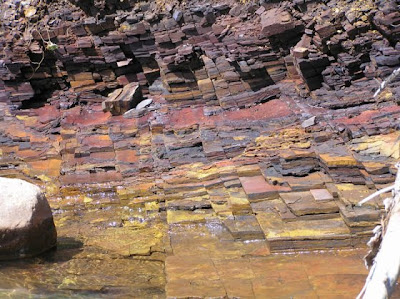
"When you pray with this pipe, you pray for and with everything." -Black Elk
We left our campground at Blue Mound State Park and headed an hours drive north to visit Pipestone National Monument.
 As often happens, when we take the big guy with us, people stop to ask if they may pet him. The comments usually sound something like "wow, I've never seen a German Shepherd that big." Here Mrs T. and Baron stand outside the Visitor Center at the monument. Of course, large dogs aren't allowed inside the museum/center, but Baron got to hike along the trail leading around the quarries.
As often happens, when we take the big guy with us, people stop to ask if they may pet him. The comments usually sound something like "wow, I've never seen a German Shepherd that big." Here Mrs T. and Baron stand outside the Visitor Center at the monument. Of course, large dogs aren't allowed inside the museum/center, but Baron got to hike along the trail leading around the quarries.
There we met a man busy at work with the precious stone. He tells us about a summer festival, just concluded, where tribal members from all over the upper midwest participated.
For countless generations, American Indians have quarried the red pipestone found at this site. These grounds are sacred to many people because the pipestone quarried here is carved into pipes used for prayer. Many believe that the pipe's smoke carries one's prayer to the Great Spirit. The traditions of quarrying and pipemaking continue here today.
Here you can see the thin layer of reddish pipestone lying between the harder quartzite.
Methods of quarrying have changed little since the process began. Quarrying is a laborious task involving weeks of work with hand tools. Today, only American Indians may continue this tradition here by permit.
 As often happens, when we take the big guy with us, people stop to ask if they may pet him. The comments usually sound something like "wow, I've never seen a German Shepherd that big." Here Mrs T. and Baron stand outside the Visitor Center at the monument. Of course, large dogs aren't allowed inside the museum/center, but Baron got to hike along the trail leading around the quarries.
As often happens, when we take the big guy with us, people stop to ask if they may pet him. The comments usually sound something like "wow, I've never seen a German Shepherd that big." Here Mrs T. and Baron stand outside the Visitor Center at the monument. Of course, large dogs aren't allowed inside the museum/center, but Baron got to hike along the trail leading around the quarries.There we met a man busy at work with the precious stone. He tells us about a summer festival, just concluded, where tribal members from all over the upper midwest participated.
For countless generations, American Indians have quarried the red pipestone found at this site. These grounds are sacred to many people because the pipestone quarried here is carved into pipes used for prayer. Many believe that the pipe's smoke carries one's prayer to the Great Spirit. The traditions of quarrying and pipemaking continue here today.
Here you can see the thin layer of reddish pipestone lying between the harder quartzite.
Methods of quarrying have changed little since the process began. Quarrying is a laborious task involving weeks of work with hand tools. Today, only American Indians may continue this tradition here by permit.
A small creek passes through the quarry area. Later, on the trail, we come across an attendant falls.
Baron and I scrambled up the hill to the top of the falls. 







A fine read but a few minutes before sinking into the feathers. Thank you.
ReplyDeleteCan't remember to have seen a long-legged German shepherd like your Baron, before.
The rock formations are nice, I have a nice sketch I did years back of that waterfall.
ReplyDeleteHandsome photos of Baron.
ReplyDeletePeople need to look around them and they discover what others have done . Hopefully we learn from what others have done.
ReplyDeleteGreat story Sr T.
ReplyDeleteInteresting to read about the pipestone, and the picture of the falls is grand. I like the sound of waterfalls, almost musical.
ReplyDeleteLooks like a nice place to visit.
ReplyDeleteI'm so glad that the permit to quarry is limited to the Indians ... if not you can be sure that a money grabbing industrialist would have ruined it by now !
ReplyDeleteVery interesting and something I knew nothing about. Like Ginnie, I am glad it is something only the Indians are allowed to do. Would love to see them make the actual pipe.
ReplyDeleteYes, a great telling. Beautiful dog.
ReplyDeleteJust east of Butte is the continental divide, called Pipestone pass. Most pipestone I've ever seen in one place.
ReplyDeleteNice pictures, TB. Good post, thanks.
I love that the pipestone is quarried in much the same manner as long ago. Very interesting. I've never seen any.
ReplyDeleteInteresting about the pipestone. Lovely waterfall picture!
ReplyDeleteI have always wanted to go to Pipestone, it looks like an interesting place.
ReplyDeleteThanks for the information (and photos) about the red pipestone. I'm glad some are continuing the tradition of making pipes from this stone.
ReplyDeleteYour dog is number one wit me. Beautiful German Shepherd. I really appreciate seeing the pipestone site. It has always fascinated me and the history of it is wonderful too.
ReplyDeleteA lovely trio you must be. That's an interesting post!
ReplyDelete